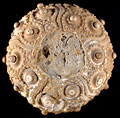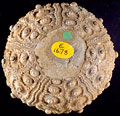|
Diagnostic Features
|
- Test subglobular, plates moderately thick.
- Apical disc about 40-50% of test diameter; dicyclic.
- Ambulacra narrow, sinuous. Pore-pairs subconjugate, the two pores somewhat elongate and separated by a moderately wide, raised interporal partition. Pore-zones incised.
- Ambulacral plating simple but becoming pseudobigeminate adorally. Every second plate with larger primary tubercle; tubercles largest and most differentiated adorally; one or two smaller tubercles perradial to the marginal series.
- Interambulacral plates only slightly wider than tall; all with a single large primary tubercle with perforate mamelon. Platform of tubercle usually with weakly developed crenulation, especially around adapical side of aboral tubercles, but smooth adorally. Mamelons becoming distinctly larger adapically.
- Areoles separate at ambitus and adapically, though may become confluent adorally; incised and generally subcircular. Scrobicular tubercles differentiated and relatively coarse. Extrascrobicular granulation rather heterogeneous and confined largely to interradial margin.
- Perignathic girdle of apophyses.
- Primary spines stout and relatively short with short neck. Shaft ornamented by rows of spinules or beaded ribs.
|
|
Distribution
|
Jurassic (Pliensbachian-Kimmeridgian), Europe. |
| Name gender |
feminine |
| Type |
Cidaris florigemma Phillips, 1829, p. 98, by subsequent designation of Savin, 1903, p. 164. |
| Species Included |
- P. (P.) florigemma (Phillips, 1829); Oxfordian, Europe.
- P. (P.) blumenbachi (Munster in Goldfuss, 1829); Oxfordian, Europe (see Radwanska 2003).
- P. (P.) laeviscula (Agassiz, 1840); Oxfordian, Europe.
- P. (P.) lamberti Savin, 1903; Kimmeridgian, France.
- P. (A.) spinulosa (Cotteau, 1875); Bajocian, France, UK [treated by Vadet as a senior synonym of Cidaris bajociensis Cotteau].
- P. (A.) microstoma (Cotteau, 1875); Bathonian-Callovian, France, UK.
- P. (A.) leberti (Vadet, 1989); Callovian, France.
- P. (A.) parandieri (Agassiz, 1840); Oxfordian, western Europe.
- P. (A.) moeschi (de Loriol, 1869); Oxfordian-Kimmeridgian, Europe.
- P. (A.) smithii (Wright, 1857): Kimmeridgian, UK, France.
- P. (A.) pichauriensis (Lambert, 1925); Pliensbachian, France.
- P. (A.) desori (Cotteau, 1857); Bathonian-Callovian, France.
- P. poucheti (Desor, 1858); Oxfordian-Kimmeridgian, France.
- P. zschokkei (Cotteau, 1875); (Aalenian?) Bajocian, western Europe.
- P. bouchardi (Wright, 1851); Aalenian, UK.
|
| Classification and/or Status |
Cidaroida, Polycidaridae.
Presumed paraphyletic by exclusion of Histocidaridae.
|
| Remarks |
Distinguished from Balanocidaris, Caenocidaris and Plegiocidaris by having heterogeneous ambulacral tuberculation developed throughout the entire length of the ambulacral zones. Distinguished from Polycidaris by its pore-pair morphology, the two pores being subconjugate and separated by a raised interporal partition, as well as by its spine morphology.
It seems likely that Paracidaris is primitive sister group to the Histocidaridae.
Pomel, A, 1883. Classification methodique et genera des Echinides vivants et fossiles. Thesis presentees a la Faculte de Science, Paris. A. Jourdan, Algar. 131 pp.
|




